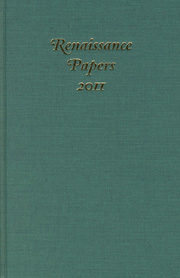Book contents
- Frontmatter
- Contents
- Dedication
- Walking, Waking, and the Armor of Light: Pauline Enactments in Henry IV, Part 1
- Costard's Revenge: Letters and Their Misdelivery in Love's Labour's Lost
- Productive Violence in Titus Andronicus
- Method in Marlowe's Massacre at Paris
- Ending Well: Mixed Genres and Audience Response in the London Theatrical Marketplace, 1604–06
- Birdlime: Sticky Entrapments in Renaissance Drama
- Sacrifice and Transcendence in Sir Philip Sidney's Astrophil and Stella
- The Quest for Certainty in Fulke Greville's A Treatie of Humane Learning
- Traces of the Masque in George Herbert's The Church
- Una Trinitas: Una and the Trinity in Book One of The Faerie Queene
- Reconsidering the 1599 Bishops' Ban on Satire
- Robert Bellarmine the Censor and Early-Modern Humanism
Una Trinitas: Una and the Trinity in Book One of The Faerie Queene
Published online by Cambridge University Press: 05 April 2013
- Frontmatter
- Contents
- Dedication
- Walking, Waking, and the Armor of Light: Pauline Enactments in Henry IV, Part 1
- Costard's Revenge: Letters and Their Misdelivery in Love's Labour's Lost
- Productive Violence in Titus Andronicus
- Method in Marlowe's Massacre at Paris
- Ending Well: Mixed Genres and Audience Response in the London Theatrical Marketplace, 1604–06
- Birdlime: Sticky Entrapments in Renaissance Drama
- Sacrifice and Transcendence in Sir Philip Sidney's Astrophil and Stella
- The Quest for Certainty in Fulke Greville's A Treatie of Humane Learning
- Traces of the Masque in George Herbert's The Church
- Una Trinitas: Una and the Trinity in Book One of The Faerie Queene
- Reconsidering the 1599 Bishops' Ban on Satire
- Robert Bellarmine the Censor and Early-Modern Humanism
Summary
Along with most commentators, I interpret Una as the Church. Unlike most, however, I understand that Church not as the English Church of Spenser's day (which, needless to say, incorporated nearly all of Elizabeth's subjects), but as the community of the redeemed. This latter community was understood to exist not only within the English Church, but also beyond it. As explained by Robert Nowell in his Catechism of 1570, the visible Church (whose claim to be a Church derives from its “sincere preaching of the gospel,” and its “invocation and administration of the sacraments”) is liable to include hypocrites among its members. It is thus to be distinguished from the invisible Church, which is constituted of “the number of the elect to everlasting life.” The latter, as implied by Nowell's generalized definition of the visible Church and the very concept of an “invisible” body, were not necessarily confined to the Church in England.
The redeemed are, by definition (and here I am adopting the phrasing of one of the Elizabethan Homilies) “partakers of [Christ's] heavenly light.” That Una does indeed “partake of “ divinity is implied by the abstractions that Spenser uses almost as alternatives for her name.
- Type
- Chapter
- Information
- Renaissance Papers 2011 , pp. 117 - 130Publisher: Boydell & BrewerPrint publication year: 2012



